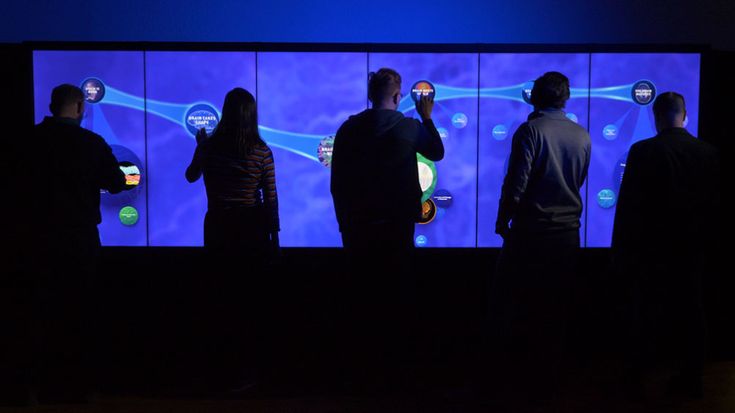The digital landscape is in a state of constant evolution, and immersive interfaces are at the forefront of this transformation. As technology advances, user journeys are being reshaped by experiences that go beyond traditional screens and inputs. Immersive interfaces blend augmented reality (AR), virtual reality (VR), mixed reality (MR), and voice as well as gesture-driven interactions to create environments that are more intuitive, engaging, and interactive. This article delves into the dynamic world of immersive interfaces, examining how they are revolutionizing user journeys, transforming industries, and setting new benchmarks for digital engagement.
In today’s competitive digital market, providing users with a compelling and seamless journey is essential for success. Businesses, developers, and designers are increasingly turning to immersive interfaces as a way to captivate audiences and enhance user experiences. Unlike traditional flat interfaces, immersive interfaces create multi-dimensional experiences that foster a deeper connection between users and technology.
The goal of these interfaces is to dissolve the boundary between the digital and physical worlds. By leveraging advanced technologies, immersive interfaces facilitate experiences where users can interact with digital content as if it were a tangible part of their environment. This article explores the key components, benefits, challenges, and future trends in immersive interface design.
What Are Immersive Interfaces?
Immersive interfaces refer to the digital systems and platforms that utilize technologies such as VR, AR, MR, and voice recognition to create engaging, multi-sensory experiences. These interfaces move beyond the conventional point-and-click model by introducing spatial, auditory, and tactile elements into user interactions.
Key Characteristics
Immersive interfaces are defined by several characteristics that differentiate them from traditional digital interactions:
A. Multisensory Engagement: They leverage visual, auditory, and haptic feedback to create a rich, engaging experience.
B. Spatial Awareness: These interfaces adapt to the user’s physical space, integrating digital content with the real world.
C. Natural Interaction: By using gestures, voice commands, and even eye tracking, immersive interfaces allow for intuitive, human-like interactions.
D. Contextual Relevance: They can adapt content based on the user’s location, behavior, and preferences, delivering personalized experiences.
The Evolution of User Journeys
User journeys have traditionally involved static web pages or mobile applications where navigation is largely linear. With the rise of immersive technologies, user journeys are becoming more dynamic and experiential. This shift is driven by several factors:
Enhanced Engagement
Immersive interfaces capture user attention by offering interactive and visually compelling experiences. Instead of passively consuming information, users are encouraged to engage actively with the content, leading to higher retention and satisfaction rates.
Emotional Connection
By creating environments that stimulate multiple senses, immersive interfaces foster a deeper emotional connection. This connection can influence decision-making, brand loyalty, and overall user satisfaction.
Seamless Integration
Modern immersive systems integrate with existing technologies and platforms, allowing for a smoother transition between different modes of interaction. This integration ensures that users experience continuity regardless of whether they are engaging with a physical product, a website, or a VR application.
Technologies Driving Immersive Interfaces
The development of immersive interfaces is made possible by a convergence of several cutting-edge technologies. Understanding these technologies is crucial for grasping the full potential of immersive user journeys.
Augmented Reality (AR)
AR overlays digital content onto the real world, enhancing the user’s perception of their environment. This technology has found applications in various industries, including retail, education, and healthcare.
A. Retail Experiences: AR enables customers to visualize products in their own space before making a purchase.
B. Educational Tools: Interactive AR applications make learning more engaging by presenting complex information in a simplified, visual format.
C. Healthcare: AR assists in medical training and patient care by overlaying digital information during surgical procedures.
Virtual Reality (VR)
VR creates a fully immersive digital environment that isolates users from the real world. It is widely used in gaming, training simulations, and virtual tours.
A. Gaming: VR gaming provides an unparalleled level of immersion, making users feel as though they are truly part of the game.
B. Training Simulations: Industries such as aviation and medicine use VR to create realistic training environments without the associated risks.
C. Virtual Tours: VR offers the possibility to explore remote locations, museums, or real estate properties from the comfort of home.
Mixed Reality (MR)
MR combines elements of both AR and VR, allowing digital and physical objects to coexist and interact in real time. This hybrid approach is particularly useful in collaborative environments and complex problem-solving scenarios.
A. Collaboration: MR facilitates virtual meetings where participants can interact with both digital content and physical surroundings.
B. Design and Prototyping: MR tools enable designers to work with 3D models in real-world settings, accelerating the prototyping process.
C. Education and Training: MR offers interactive learning environments that blend digital simulations with real-world elements.
Voice and Gesture Recognition
Voice assistants and gesture-based controls have become integral components of immersive interfaces. These technologies allow for hands-free interaction and create a more natural communication channel between users and digital systems.
A. Voice Commands: Voice recognition technology allows users to control devices and access information through spoken commands.
B. Gesture Controls: Using cameras and sensors, systems can interpret hand gestures to navigate interfaces, adjust settings, or trigger actions.
C. Facial Recognition: Some immersive interfaces include facial recognition to personalize experiences and enhance security.
Transforming Industries with Immersive Interfaces
Immersive interfaces are not confined to one sector; they are transforming a variety of industries by enhancing user journeys and creating innovative solutions.
Retail and E-commerce
In the retail sector, immersive interfaces have redefined how customers interact with products and brands. Retailers are now using AR and MR to provide virtual try-ons, 3D product visualizations, and interactive store experiences.
A. Virtual Showrooms: Customers can explore virtual showrooms that replicate the physical store experience online.
B. Product Customization: AR tools allow users to customize products in real time, visualizing different colors, styles, and configurations.
C. Enhanced Customer Service: Voice assistants and chatbots integrated into immersive interfaces provide instant customer support, improving overall satisfaction.
Education and Training
The educational sector has been significantly impacted by immersive technologies, which have introduced new methods for interactive and experiential learning.
A. Virtual Classrooms: VR and AR facilitate immersive learning environments where students can explore historical sites, scientific phenomena, and more.
B. Interactive Labs: Immersive interfaces enable virtual laboratories where students can conduct experiments without the limitations of a physical lab.
C. Professional Training: Industries such as aviation, medicine, and manufacturing use VR simulations to train employees in a controlled, risk-free environment.
Healthcare
Healthcare is another domain experiencing transformative changes thanks to immersive interfaces. These technologies enhance both patient care and medical training.
A. Surgical Simulations: VR provides surgeons with realistic simulations to practice complex procedures before performing them on patients.
B. Patient Rehabilitation: Immersive interfaces offer interactive rehabilitation programs that engage patients in recovery exercises.
C. Medical Education: AR applications help medical students visualize and understand complex anatomical structures, improving comprehension and retention.
Entertainment and Gaming
The entertainment industry has long been a pioneer in adopting immersive technologies. Gaming, in particular, has evolved with the integration of VR and AR, providing unparalleled levels of immersion.
A. Immersive Gaming Experiences: VR gaming transports players into elaborate digital worlds, creating lifelike experiences.
B. Interactive Storytelling: Immersive interfaces allow for branching narratives and interactive storytelling, where users influence the storyline.
C. Virtual Concerts and Events: AR and VR platforms enable users to attend virtual concerts and live events, breaking geographical barriers and redefining audience engagement.
Real Estate and Architecture
Immersive interfaces are revolutionizing real estate and architectural design by enabling virtual tours, interactive blueprints, and design visualizations.
A. Virtual Property Tours: Potential buyers can explore properties through VR tours, reducing the need for physical visits.
B. Design Visualization: Architects use immersive technologies to present designs in 3D, allowing clients to experience a building before it is constructed.
C. Urban Planning: Mixed reality applications assist urban planners in visualizing and designing future cityscapes, considering both aesthetics and functionality.
The Impact on User Journeys
Immersive interfaces have a profound effect on user journeys by fundamentally altering the way users interact with digital content and services. These interfaces not only enhance engagement but also streamline processes, improve accessibility, and foster deeper emotional connections.
Personalization and Adaptability
One of the most significant impacts of immersive interfaces is the ability to deliver highly personalized experiences. By leveraging data analytics, AI, and contextual awareness, these systems can tailor content and interactions to individual users.
A. Context-Aware Experiences: Immersive interfaces adjust content based on user location, behavior, and preferences.
B. Adaptive Learning: Systems can adapt in real time to user responses, ensuring that interactions remain relevant and engaging.
C. Customized Feedback: Personalized notifications and feedback mechanisms help users navigate their journeys more effectively.
Enhanced Engagement and Retention
By offering multisensory experiences and natural interaction methods, immersive interfaces increase user engagement and retention. Users are more likely to return to platforms that offer innovative, interactive, and visually stunning experiences.
A. Interactive Storytelling: Narrative-driven experiences that react to user choices can increase emotional investment.
B. Gamification: Incorporating game elements into user journeys—such as rewards, challenges, and leaderboards—can motivate continued interaction.
C. Real-Time Interaction: Immediate feedback through voice, gesture, or haptic responses ensures that users feel connected to the experience.
Overcoming Traditional Barriers
Traditional interfaces can sometimes limit how users interact with digital content, often requiring multiple steps to achieve a single task. Immersive interfaces simplify these interactions by reducing friction and making digital environments more intuitive.
A. Natural Navigation: Gesture and voice controls remove the need for complex menus and buttons.
B. Intuitive Learning Curves: Users can learn by interacting naturally with digital elements, bypassing the steep learning curves associated with conventional systems.
C. Seamless Transitions: Integration between physical and digital realms allows for a more cohesive experience, whether users are browsing a website, interacting with a VR application, or using an AR tool.
Challenges and Considerations
While immersive interfaces offer tremendous opportunities, they also present a unique set of challenges. Addressing these challenges is critical for the widespread adoption and long-term success of immersive technologies.
Technical Challenges
Implementing immersive interfaces requires advanced hardware, software, and network infrastructures. Developers and businesses must overcome several technical hurdles:
A. High-Performance Hardware: Immersive experiences demand robust processing power and high-quality displays, which can be costly and require frequent upgrades.
B. Connectivity Requirements: Seamless immersion depends on reliable, high-speed internet connectivity to handle data-intensive applications.
C. Integration with Legacy Systems: Merging new immersive technologies with existing systems often involves overcoming compatibility issues and ensuring a smooth transition.
User Adaptation
For immersive interfaces to succeed, users must be willing to embrace new modes of interaction. This process can be hindered by:
A. Learning Curve: New interaction methods such as gesture control or voice commands may require users to adapt their behaviors.
B. Accessibility Issues: Ensuring that immersive interfaces are accessible to people with disabilities is crucial for inclusive design.
C. Privacy Concerns: As immersive systems gather detailed data about user behavior and environments, addressing privacy and security concerns is essential.
Cost and Investment
The development and implementation of immersive interfaces often require significant upfront investment. Businesses must weigh the long-term benefits against the initial costs involved in:
A. Research and Development: Developing proprietary technologies or adapting existing systems to support immersion can be resource-intensive.
B. Infrastructure Overhaul: Upgrading hardware, software, and network capabilities may be necessary to support high-quality immersive experiences.
C. Ongoing Maintenance: Regular updates, system maintenance, and user support add to the long-term cost considerations.

Future Trends in Immersive Interfaces
The evolution of immersive interfaces is far from complete. Several emerging trends indicate that these technologies will continue to redefine user journeys in innovative ways.
Artificial Intelligence and Machine Learning Integration
The convergence of immersive technologies with AI and machine learning is set to further personalize and optimize user interactions. Future developments may include:
A. Predictive Interactions: Systems that learn from user behavior to predict and streamline future interactions.
B. Dynamic Content Adaptation: AI-driven content that changes in real time based on user responses and environmental factors.
C. Emotion Recognition: Advanced systems capable of detecting user emotions through facial expressions or vocal cues, adapting the experience to enhance engagement.
Expansion of Wearable Technologies
Wearable devices are becoming increasingly integrated with immersive experiences. This trend will likely continue as wearables evolve to offer more advanced sensors and connectivity options:
A. Enhanced AR Glasses: Lightweight, high-resolution smart glasses that project digital information seamlessly into the user’s field of vision.
B. Haptic Wearables: Devices that provide tactile feedback to simulate textures, temperature, and resistance, further enhancing the immersive experience.
C. Biometric Integration: Wearables that monitor physical responses, enabling adaptive systems that adjust based on stress, excitement, or fatigue levels.
Increased Focus on Ethical and Inclusive Design
As immersive interfaces become more prevalent, there will be a stronger emphasis on ethical design and inclusivity. This shift is vital for ensuring that technological advances benefit all users:
A. Data Privacy Regulations: Enhanced regulatory frameworks to protect user data and ensure transparency in how immersive systems collect and use information.
B. Universal Design Principles: Developing interfaces that are accessible and intuitive for users of all ages, abilities, and technological proficiencies.
C. Ethical AI Implementation: Ensuring that AI and machine learning components in immersive interfaces are designed and deployed responsibly.
Cross-Industry Collaboration
The success of immersive interfaces relies on the collaboration between various sectors, including technology, healthcare, education, and entertainment. Future trends point toward:
A. Interdisciplinary Research: Collaborative efforts that combine expertise from different fields to push the boundaries of what immersive interfaces can achieve.
B. Global Standards and Protocols: The development of universal standards to ensure that immersive technologies work seamlessly across devices and platforms.
C. Open Innovation Platforms: Communities and ecosystems that encourage the sharing of best practices and innovative solutions across industries.
Best Practices for Designing Immersive Interfaces
Creating compelling immersive interfaces requires a deep understanding of both technological capabilities and human behavior. Here are some best practices to consider when designing these systems:
A. User-Centered Design: Prioritize the needs, preferences, and behaviors of users in every stage of the design process.
B. Iterative Prototyping: Employ rapid prototyping and user testing to refine interactions and ensure that the interface is intuitive and engaging.
C. Seamless Integration: Ensure that immersive elements complement, rather than complicate, the overall user journey by integrating them naturally with existing platforms.
D. Focus on Accessibility: Incorporate accessibility features from the outset to create inclusive experiences that cater to a diverse user base.
E. Robust Security Measures: Implement advanced security protocols to safeguard user data and maintain trust in immersive systems.
Real-World Applications and Case Studies
Several pioneering companies and organizations have already implemented immersive interfaces to transform user journeys. Examining these real-world examples provides insights into how these technologies are applied effectively.
Case Study: Retail Transformation
A global retail brand introduced an AR-based mobile application that allows customers to visualize products in their own homes. Users can:
A. Experience 3D Models: Rotate and zoom in on products to inspect details closely.
B. Customize Options: Experiment with different colors, sizes, and configurations in real time.
C. Interactive Buying Journey: Seamlessly transition from product exploration to checkout with integrated payment options.
This application not only boosted customer engagement but also reduced product returns by providing more accurate visualizations of the products.
Case Study: Virtual Training in Healthcare
A leading hospital system has integrated VR simulations into its training programs for medical professionals. These simulations provide:
A. Realistic Surgical Scenarios: Trainees practice complex procedures in a risk-free environment.
B. Performance Feedback: Real-time analytics help trainees understand their strengths and areas for improvement.
C. Enhanced Learning Retention: Immersive experiences lead to better knowledge retention compared to traditional training methods.
The initiative has significantly improved training outcomes and reduced errors in real-life medical procedures.
Case Study: Educational Immersion
An international education institution developed a mixed reality platform for virtual classrooms. This platform offers:
A. Interactive 3D Lessons: Students explore historical sites and scientific phenomena through immersive 3D environments.
B. Collaborative Projects: Learners can interact and collaborate on projects within a shared digital space.
C. Real-Time Assessments: Educators receive instant feedback on student performance, allowing for timely interventions and personalized support.
These case studies illustrate the tangible benefits of immersive interfaces, including improved user satisfaction, enhanced learning experiences, and increased operational efficiency.

The Road Ahead for Immersive Interfaces
As technology continues to advance, the potential for immersive interfaces to reshape user journeys will only grow. Future innovations are likely to focus on increasing realism, improving accessibility, and integrating more sophisticated AI capabilities. Companies and developers must continue to invest in research and development while keeping user needs at the center of their efforts.
Anticipated Innovations
Future immersive interfaces may include breakthroughs such as:
A. Hyper-Realistic Virtual Environments: Enhanced graphics and sensory feedback will create virtual worlds that are nearly indistinguishable from reality.
B. Fully Integrated Ecosystems: Seamless connections between different immersive platforms will provide users with a consistent experience across various devices and contexts.
C. Emotionally Intelligent Interfaces: Advanced AI capable of reading and responding to user emotions, creating experiences that adapt in real time to a user’s mood and context.
The Importance of Continuous Learning
For businesses and designers, staying abreast of trends and continually refining their approach is essential. This involves:
A. Investing in Training: Keeping teams updated on the latest immersive technologies and design principles.
B. Engaging with Communities: Participating in industry forums, conferences, and workshops to share knowledge and gain insights from peers.
C. Feedback Loops: Regularly gathering and analyzing user feedback to iterate and improve immersive interfaces over time.
Conclusion
Immersive interfaces are transforming user journeys by creating experiences that are engaging, intuitive, and deeply personalized. Through the integration of AR, VR, MR, and advanced interaction technologies, digital environments are evolving to become more lifelike and responsive. As we move forward, these technologies will continue to break down the barriers between the digital and physical worlds, offering unprecedented levels of engagement and interactivity.
The impact of immersive interfaces is evident across diverse sectors—from retail and education to healthcare and entertainment. By rethinking traditional user journeys and incorporating multisensory experiences, businesses can foster stronger emotional connections, enhance user satisfaction, and drive sustainable growth. However, the path is not without challenges. Technical hurdles, cost considerations, and the need for ethical, inclusive design practices must all be addressed as immersive interfaces become mainstream.
In an era where digital experiences are paramount, embracing immersive interfaces is not merely an option but a necessity. By investing in innovation and staying attuned to user needs, organizations can unlock new possibilities for engagement and redefine what it means to interact with technology.
As the digital landscape continues to evolve, immersive interfaces will play a pivotal role in shaping the future of user journeys. The fusion of technology and human-centric design promises a future where the boundaries of reality are expanded, and every interaction is an opportunity for deeper connection and meaningful engagement.














